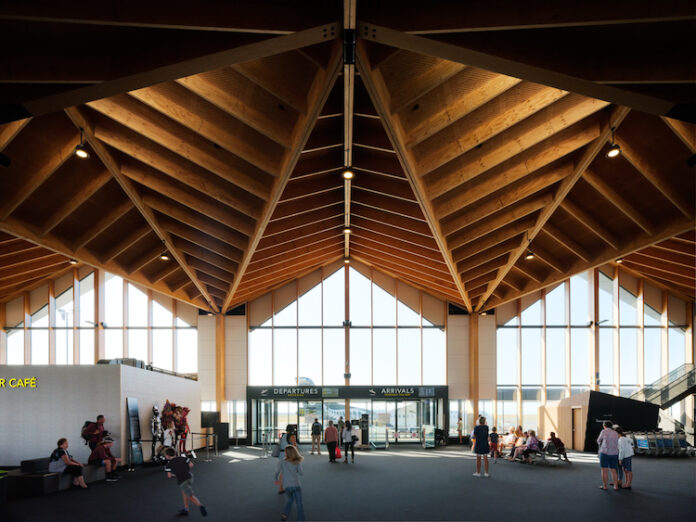
The use of timber to reduce climate-changing emissions from the local construction industry has become easier and more accessible with the launch of Timber Unlimited to builders, designers, architects, engineers, quantity surveyors and others involved in the building sector throughout New Zealand.
Formerly the Timber Design Centre, the new name Timber Unlimited reflects a commitment to being the leader in timber design and innovation, and providing information to make it easy to choose and use more timber in construction.
Using funding through the government’s Forestry and Wood Processing Industry Transformation Plan (ITP), Timber Unlimited is a practical initiative offering research, technical expertise, tools, guidance and information to promote the use of wood in building and infrastructure projects across the nation’s commercial, industrial, multi-storey and public sectors.
Timber Unlimited director Robert Finch says carbon emissions from the construction sector increased by a staggering 66% in the past decade, with the industry now responsible for between 15% and 20% of New Zealand’s total emissions.
“Using more timber in the design and construction of structures throughout the wider industry will markedly decrease these emissions, through its ability to displace more carbon-intensive materials and store carbon dioxide within the wood itself,” Finch says.
“A Te Uru Rakau — New Zealand Forestry Service study found that if the industry replaced around half of its current use of steel and concrete with timber, it could reduce our national embodied carbon dioxide emissions by half a billion tonnes each year.”
Finch says Timber Unlimited will also work to dispel many myths about using timber in New Zealand.
“Mass timber is not as commonplace as it could be in structures due to lack of industry experience with it, misinformation, and preconceptions such as believing it was too expensive, would not stand up to a fire, or was not structurally as sound.
“None of this is true, and there are an escalating number of buildings around the world that demonstrate this.
“Timber is sustainable, easy to use, highly flexible in its uses, and compares more than favourably with other building materials in terms of cost and strength — and that’s before the lower carbon footprint of timber is taken into account.
“Part of creating www.timberunlimited.co.nz is to build belief in the possibilities of timber. We have created a programme called Timber Decoded — this will help dispel common myths and preconceptions about timber,” Finch says.
Iconic New Zealand architecture firm Warren and Mahoney are strong wood advocates, using timber extensively in their award-winning buildings
Principal Simon Hardy says the company believes mass timber not only creates beautiful, cost-effective architecture, but also that it has huge potential for reducing carbon emitted in construction.
“As designers, and as an industry, we can and must embrace innovation and sustainable practice by building the expertise, technology, and knowledge to drive change,” Hardy says.
“Warren and Mahoney has formed an Advanced Timber Unit to help support the advancement of low-carbon mass timber design, as we know the potential is huge.”
To assure its attraction and accessibility to the industry, Timber Unlimited was developed following careful research, and listening to the needs of sector professionals and builders, Finch says.
“This gave us insight and information about how Timber Unlimited can positively influence perceptions about timber and building material choices.
“Importantly, it highlighted the perceived barriers to using wood, specifically in commercial construction. This information has proven critical for Timber Unlimited to dispel myths and concerns around wood, and to increase creativity, confidence and, ultimately, a surge in its use throughout our industry.”
Naylor Love director Scott Watson says increased use of mass timber in the commercial construction area provides the industry the best opportunity to make a significant impact on lowering carbon.
“Timber will give you the best bang for your buck and a positive carbon saving, while also creating amazing spaces to work and live,” Watson says.
PTL technical director and NZ Timber Design Society president Daniel Moroder agrees with the cost, aesthetic, and carbon benefits of timber, adding that timber also creates buildings that are good for the people in them.
He says studies into the phenomenon of “biophilia” (a love of life or living things) show that humans thrive in more natural environments.
“Being in or around nature makes people feel good. It’s been shown that the use of visible timber in a building promotes a sense of nature, making people feel more well, relaxed, and productive.
“Wood is, therefore, a fantastic material to use in office blocks, schools and even hospitals,” Moroder says.
Finch ends by saying: “The Timber Unlimited service will make wood materials more attractive, and arm the industry with the capability and knowledge to replace emissions-intensive materials with wood.
“This would empower the industry to speed up the journey to a lower-emissions future, and make a real difference to Aotearoa New Zealand.”



